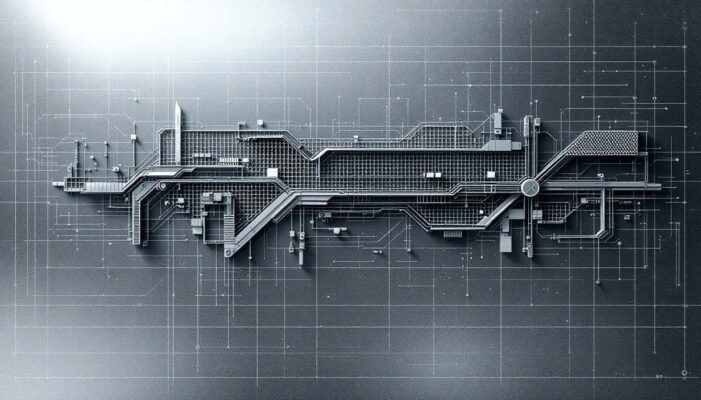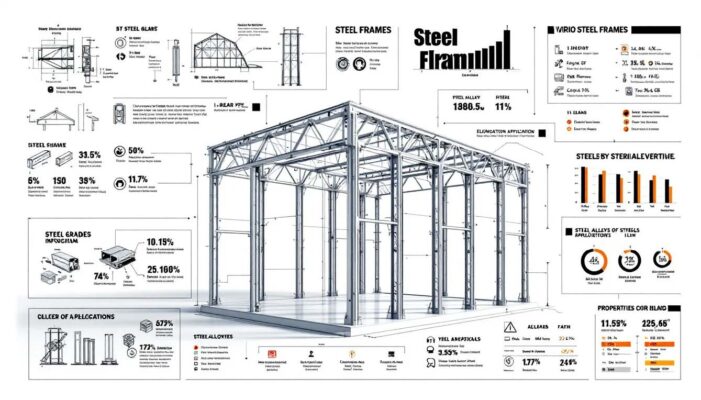Aluminium
Aluminium Profiles vs Composite Materials
Aluminium Profiles vs Composite Materials: A Comparative Analysis for Structural Framing
 In the realm of structural framing, selecting either aluminium profiles or composite materials can greatly influence your project’s outcome. A thorough comparative analysis investigates the properties of these materials, their structural integrity, associated costs, and environmental consequences to provide a comprehensive view. This examination ensures you’re informed to make an optimal choice that suits your unique framing needs based on material characteristics and performance metrics.
In the realm of structural framing, selecting either aluminium profiles or composite materials can greatly influence your project’s outcome. A thorough comparative analysis investigates the properties of these materials, their structural integrity, associated costs, and environmental consequences to provide a comprehensive view. This examination ensures you’re informed to make an optimal choice that suits your unique framing needs based on material characteristics and performance metrics.
Introduction to Structural Framing
Structural framing is a crucial aspect of building design and construction, providing the framework for a building’s walls, floors, and roof. Traditional materials such as wood, steel, and concrete have been used for centuries, each offering unique benefits and challenges. Wood, for instance, is easy to work with and provides good thermal insulation but is susceptible to rot and pests. Steel, on the other hand, offers high strength and durability but can be prone to corrosion if not properly treated. Concrete provides excellent compressive strength but is heavy and requires significant labor to install.
Advancements in technology and materials science have led to the development of alternative materials and framing systems that address some of the limitations of traditional materials. These innovations aim to improve the performance, sustainability, and cost-effectiveness of structural framing. In this section, we will explore the basics of structural framing, including the different types of framing systems, materials, and design considerations.
Key Takeaways
Aluminium profiles and composite materials each have distinct properties that make them suitable for different structural framing applications, with aluminium providing high strength-to-weight ratios and composites offering superior flexural strength and durability.
Cost analysis is crucial in selecting materials, as aluminium profiles generally have lower initial costs while composite materials may offer long-term savings through reduced maintenance and longer service life.
Environmental impact and sustainability are significant factors in material selection, with aluminium’s energy-intensive production calling for effective recycling, while composites present challenges regarding recyclability despite their lower energy footprint.
When the carbon content in iron alloys exceeds 2 percent, the resulting material is categorized as cast iron, highlighting its distinction from steel, which is primarily composed of iron and carbon with a lower carbon content.
Historical Background
Tracing back to ancient times, the use of composite materials began with the creation of plywood in ancient Mesopotamia around 3400 B.C., where wood strips were bonded together. The evolution took a revolutionary turn in the 20th century when Owens Corning introduced glass fiber, marking an innovation that established the foundation for what would become the first industry based on fiber-reinforced polymers during the 1930s.
The advancement continued as a significant landmark was achieved in 1961 with the patenting of carbon fiber. This marked a groundbreaking moment by introducing a material capable of providing unprecedented strength-to-weight ratios and versatility across numerous sectors.
By mid-1990s, there was widespread incorporation of composite materials into manufacturing and construction practices. These versatile materials found their way into numerous applications ranging from high-tech aerospace engineering to everyday residential building projects due to their adaptability and robustness under various conditions.
This historical journey underscores how composite materials have advanced over time, demonstrating their practicality alongside conventional construction elements like aluminum profiles used within modern structural framing systems.
Material Composition and Mechanical Properties
The physical and mechanical properties of materials play a vital role in assessing their appropriateness for use as structural components. Materials such as aluminium profiles and composite materials exhibit unique attributes that render them beneficial under different circumstances, especially when considered for construction applications. Understanding these material properties through the lens of their composition and reinforcement elements is key to appreciating their significance.
Steel production is crucial due to its widespread use in infrastructure and industry. Steel, composed mainly of iron and carbon, boasts properties like high tensile strength and durability. Global steel production far exceeds that of other engineering metals, such as aluminum, underscoring its dominance and utility.
Aluminium profiles are crafted predominantly from pure aluminium mixed with alloying agents like silicon, magnesium, and manganese to bolster certain mechanical characteristics, including tensile strength and pliability. In contrast, composite materials are engineered by integrating a reinforcing element — which can be carbon or glass fiber — into a foundational matrix material such as epoxy or polyester resin. This combination results in superior strength relative to weight ratios along with commendable resistance against heat and corrosive chemicals.
Aluminium Profiles
Profiles made of aluminium are highly valued in the construction sector for their remarkable combination of being light yet possessing strong mechanical properties. These profiles are essentially formed from pure aluminium and often include elements such as silicon and magnesium to enhance their mechanical strength, along with improving pliability. This results in achieving a modulus of elasticity that can range between 69.5 GPa and 73 GPa, providing the necessary stiffness required for many different uses.
Featuring thermal conductivity values ranging around 197 W/m.K to 205 W/m.K, these aluminium profiles enable effective heat dispersion within structural contexts. Their densities lie between approximately 2,66 Mg/m3 and 2,72 Mg/m3 which underscores their lightweight characteristic—a crucial benefit during construction endeavors where simple maneuverability and transportation play key roles.
With regards to tensile strength, it lies within the spectrum of 233 MPa up to about 257 MPa. This capacity positions them well for applications involved in supporting loads such as those needed by buildings or bridges. The fusion of these traits together with commendable resistance against corrosion secure aluminum profiles’ position as trustworthy materials dedicated towards maintaining structural integrity under various environmental scenarios.

Composite Materials
On the contrary, composite materials are intentionally crafted by amalgamating reinforcement substances like carbon or glass fiber with a foundational matrix material such as epoxy or polyester resin. The resulting compound material boasts an optimal balance of strength and lightness, rendering it perfectly suited for structural endeavors that necessitate robustness while maintaining a low weight profile.
Within the realm of composite materials, there are types such as carbon-fiber reinforced polymers (CFRP) and glass-fiber reinforced polymers (GFRP). Each type offers specific benefits. CFRPs stand out due to their outstanding tensile strength coupled with reduced heaviness, whereas GFRPs excel in resisting thermal influences and chemical interactions. Such attributes make these materials exceedingly effective and long-lasting when subjected to various environmental stresses.
The mechanical properties of composites hinge on the effectiveness of how well reinforcement components integrate with the matrix phase. This union imparts composites with anisotropic qualities — this means they react differently under stress depending on which direction force is applied — thereby infusing additional intricacy into how these engineered materials behave within their intended applications.
Structural Performance
Within the realm of structural framing, the ability to endure diverse loading conditions is critical. Aluminium profiles, composite materials, and steel framing each possess distinct strengths regarding their capacity to support loads and withstand wear over time. These characteristics influence which material is chosen for particular construction tasks.
Aluminium profiles often exhibit a greater ultimate strength when subjected to axial loading. This makes them more suitable for structures that need to carry heavy weights. Conversely, composite materials are noted for their enhanced flexural strength, enabling them to resist bending forces efficiently in certain situations.
Composites offer additional benefits such as lower maintenance needs and better resistance against chemical attacks, making them highly beneficial for specific applications requiring these properties.
Load-Bearing Capacity
The capability to support loads is a key criterion in assessing materials for use in construction. Aluminum profiles are frequently selected due to their superior strength-to-weight ratio, which allows the creation of light yet durable structures. This trait positions aluminum beams as favorable options for edifices and viaducts that demand considerable strength and rigidity.
Aluminum alloy pillars possess attributes such as being lightweight, possessing high tensile strength, and resistance to corrosion—all of which boost their ability to carry loads effectively. Meanwhile, composite materials like carbon fiber composites boast remarkable tensile strengths coupled with excellent ratios of strength-to-density, making them perfect choices when it’s imperative to minimize weight.
Due to the anisotropic nature of composite materials—where mechanical characteristics change according to loading direction—they present unique benefits and challenges depending on usage. Nevertheless, the integration of continuous fibers into these composites delivers exceptional reinforcement contributing significantly higher tensile strengths than those achievable by aluminium profiles.
In summarizing both aluminium sections along with other types of composite materials hold significant importance within fields involving structural applications. Each comes laden with distinct capacities appropriate to different environments where they’re subjected to load demands.
Durability, Corrosion Resistance, and Maintenance
The enduring nature and upkeep requirements are crucial factors in the selection of materials for building projects. Aluminium sections are sought after due to their remarkable ability to resist corrosion, which renders them apt for a variety of environmental settings. This characteristic not only promotes the structures’ lifespan, but also diminishes the frequency at which maintenance is necessary.
Enhancements in mechanical characteristics and resistance to corrosion can be achieved through heat treatment techniques applied to aluminium alloys, boosting their already significant durability. Meanwhile, composite materials have garnered attention within the realm of construction for their long-term cost-effectiveness attributed mainly to lower ongoing maintenance expenses.
Utilizing beams made from an amalgamation of fiber-reinforced polymer (FRP) reinforced with aluminium alloy-concrete composites could lead to longer-lasting structures by potentially cutting down on maintenance costs over time. While each material presents its own set of strong attributes as solutions, assessing performance and longevity against specific environmental challenges remains imperative for guaranteeing sustained structural integrity throughout their service life.
Fabrication and Installation
The practical application of aluminium profiles and composite materials in the construction sector is significantly influenced by the manufacturing and installation methodologies. These steps not only have ramifications for the project’s schedule, but also affect how these materials will perform over time.
Thanks to their lightweight nature, aluminium profiles often offer a more straightforward installation process, as they come in pre-fabricated sections that facilitate rapid assembly. Working with composite materials requires specialized methods for handling and joining, like adhesive bonding or creating mechanical joints, which may alter the simplicity of their incorporation into structures.
Production Processes
The manufacturing of aluminium profiles encompasses various phases, including extrusion, where heated aluminium is forced through a die to attain particular cross-sectional designs. The casting technique involves melting the metal down and pouring it into molds to achieve intricate forms. Rolling serves to diminish the thickness of aluminium blocks by passing them between rollers, which results in producing foils as well as sheets and plates.
Cold-formed steel framing often involves combining iron ore and steel scrap in a Basic Oxygen Furnace. This process supports the sustainability and efficiency of modern construction, highlighting how steel scrap contributes to producing lightweight, durable steel components that have significant environmental benefits.
Composite materials are developed using different strategies that each possess distinct benefits. For example, hand layup is a manual process involving resin application alongside reinforcement that serves well for small-scale detailed work while remaining cost-efficient.
In scenarios requiring greater precision on an expanded scale, vacuum bagged wet layup enhances laminate quality by employing a vacuum to press together layers whilst expelling surplus resin ahead of hardening the material. Filament winding is employed for creating tubular sections. This involves enveloping rotating mandrels with fibers soaked in resin, an approach best suited for constructing elements demanding robust strength.
Pre-preg substances come already saturated with resin and enable the crafting of high-performance composite pieces characterized by meticulously regulated amounts of resin thereby augmenting the end product’s caliber considerably. Collectively these production techniques present specific pros and cons, hence selecting an appropriate method relies critically upon the particular demands posed within a construction initiative.

Ease of Installation
When selecting materials for construction, the simplicity of installation is a crucial consideration. Aluminium profiles stand out due to their lightweight nature, which facilitates easier handling and transport. This attribute accelerates the on-site assembly process, thereby cutting down labor expenses and shortening the time needed to finalize construction ventures. The swiftness associated with using aluminium makes it an effective solution for extensive projects.
In contrast, composite materials blend lightness with strength, but require distinct joining techniques like adhesive bonding or mechanical fasteners. These procedures streamline installation yet require meticulous preparation and implementation to preserve structural integrity. Thanks to their reduced heftiness, composite materials can be shifted into place more readily during setup, contributing to quicker completion times for projects.
The intricacy of setting up these two material types ultimately hinges on specific project requirements and the proficiency of those installing them. Aluminium profiles present ease in assembly processes while composites offer design versatility that may prove beneficial within intricate building contexts.
Cost Analysis
The selection of materials for structural framing is heavily influenced by cost considerations, necessitating a thorough evaluation of both immediate and ongoing expenses to establish the most economically viable option for any particular endeavor. Aluminium profiles and composite materials have distinct economic consequences which can significantly affect the total expenditure on construction undertakings.
Expenses incurred at the outset typically encompass costs associated with acquiring raw material, processing methods, and setup procedures. Due to mature production methodologies, aluminium profiles may be accompanied by reduced upfront costs when compared to composite materials. The latter might entail increased initial expenditures as they require more intricate manufacturing techniques.
Initial Costs
The production of aluminum involves upfront costs tied to the extraction, purification, and molding of the raw material. These steps are energy-intensive and consume substantial resources that can impact a construction project’s initial financial planning. Thanks to well-established procedures for producing aluminium, its market cost remains competitive with steady supply conditions.
Contrastingly, composite materials may entail more considerable beginning expenses due to their complex manufacturing requirements necessary for crafting advanced composites. Production methods like vacuum bagging or filament winding and utilizing pre-impregnated materials contribute to elevating these early stage investments. Nevertheless, the superior adaptability and enhanced performance characteristics offered by composite materials often make up for their steeper preliminary costs in specific uses.
When evaluating options within construction endeavors between aluminum profiles and composite substances, an extensive analysis centered on both immediate expense implications as well as prospective future financial impacts. Although opting for aluminium might seem economically favorable initially due to lower entry-level charges. Factoring in potential savings such as lesser part numbers and curtailed production outlays could tip the scales towards selecting composites despite higher onset prices.
Long-Term Costs
Taking into account the long-term financial implications, particularly in terms of upkeep and resilience, is essential. Owing to their inherent resistance to corrosion and decay, composite materials frequently lead to reduced maintenance expenditures. This resilience means that structures will require less frequent repairs or replacements over time, which can result in significant cost savings throughout the life of a structure.
Even though composite materials may have higher initial costs than aluminum profiles, their extended durability and minimal maintenance requirements render them an economically viable solution over time. The infrequent need for ongoing upkeep combined with their capacity to endure severe environmental conditions without considerable degradation Enhances the economic advantages they provide as time goes on.
While aluminum profiles might be more affordable upfront, they can accrue extra costs down the line due to necessary maintenance and potential repairs—particularly when used in settings susceptible to corrosive elements and chemical interactions. Nevertheless, advances made in heat treatment methods along with alloy enhancements have augmented both strength and utility for aluminium profiles, mitigating some future expenses associated with these issues.
When determining whether aluminium profiles or composite materials are more appropriate options, it necessitates assessing total ownership costs—which include immediate as well as enduring financial commitments. Assessing each project’s unique demands alongside anticipated material longevity equips construction experts with the ability to craft decisions that judiciously weigh expense against functionality.
Environmental Impact
In the realm of construction, choosing materials with minimal environmental impacts is becoming increasingly crucial. The sustainability of building practices hinges on thoroughly assessing the ecological effects associated with aluminium profiles and composite materials. Evaluating elements like energy consumption for production, potential for recycling, and associated health risks are key in determining these materials’ overall environmental footprint.
Producing aluminium stands out as a particularly energy-hungry process, consuming roughly 200 gigajoules (GJ) per ton produced—substantially more than what’s needed to produce steel. This stark difference highlights why recycling plays a critical role in lessening the environmental toll of aluminium manufacturing.
Conversely, despite their typically lower initial energy requirements during production compared to producing aluminum or steel, composite materials pose difficulties when it comes to end-of-life scenarios regarding both recyclability and safe disposal due to their complex nature.
Sustainability
Selecting materials for building projects requires careful consideration of sustainability. Both aluminium profiles and composite materials can be crafted to enhance their recyclability, thereby reducing energy use and shrinking their environmental footprints. Given the considerable amount of energy required to produce aluminium, improving recycling processes is critical in lessening its environmental effects.
Composite materials are often seen as having a more environmentally friendly impact due to their lighter weight that contributes to lower energy needs when being transported. Pultruded fiberglass composites possess outstanding corrosion resistance, which makes them perfectly suitable for harsh environments while also curtailing the necessity for regular replacements.
The advantageous attributes of composite materials such as thermal and chemical resistance alongside electrical insulation capacities also amplify their sustainable nature by guaranteeing lasting durability and minimal maintenance demands. These features make composites increasingly preferable options within eco-conscious construction approaches.
To summarize, both material choices carry ecological consequences. Nevertheless, evaluating each option against project-specific sustainability objectives remains imperative. Assessments should take into account factors like overall energy utilization, potential for recycling, and enduring durability—allowing those in the construction field to align with practices geared toward sustainable progress.
Health and Safety
The health and safety of workers are of the utmost importance when dealing with construction materials. The risks that come from handling composite materials, including aluminium oxide, such as exposure to harmful dust, shards of metal and toxic fumes, require thorough protective protocols. It is imperative for a safe work environment to have adequate personal protective equipment (PPE) available.
Effective ventilation systems play a crucial role in these environments by reducing respiratory hazards caused by airborne contaminants produced during processing activities. Maintaining rigorous adherence to established safety guidelines along with deploying robust protection measures is vital for diminishing health dangers related to working with aluminium and composite materials.
Ensuring the well-being of workers through dedicated attention to health and safety not only facilitates a safer workplace, but also helps uphold the quality standards necessary in utilizing construction-grade materials effectively. This approach enhances both occupational security and adds value toward achieving enduring outcomes within the field of construction.
Alternative Materials
In recent years, there has been a growing interest in alternative materials for structural framing, driven by concerns about sustainability, energy efficiency, and cost. These materials offer unique properties that can enhance the performance and longevity of structures. Some of the alternative materials being used in structural framing include:
- Aluminum Alloys: Aluminum alloys are being used increasingly in structural framing due to their high strength-to-weight ratio, corrosion resistance, and recyclability. The addition of elements such as silicon and magnesium enhances their mechanical properties, making them suitable for a wide range of applications. Aluminum alloys are also lightweight, which simplifies transportation and installation, reducing overall construction time and costs.
- Composite Materials: Composite materials, such as fiber-reinforced polymers (FRP), are gaining popularity in structural framing due to their high strength, low weight, and resistance to corrosion and fatigue. These materials combine a reinforcing element, like carbon or glass fiber, with a matrix material, such as epoxy or polyester resin. This combination results in superior mechanical properties and durability, making composites ideal for applications where traditional materials might fail.
- Cold-Formed Steel: Cold-formed steel is a type of steel that is formed at room temperature, rather than being heated and shaped. This process results in a material that is both strong and lightweight, making it an attractive option for structural framing. Cold-formed steel is also cost-effective and easy to work with, offering a versatile solution for various construction projects. Its high strength-to-weight ratio and resistance to corrosion further enhance its appeal.
Design Considerations
When designing a structural framing system, several factors must be taken into account to ensure the structure’s safety, durability, and efficiency. These considerations include:
- Load-Bearing Capacity: The framing system must be able to support the weight of the building, as well as any external loads such as wind and snow. This requires a thorough understanding of the material properties and how they interact under different loading conditions. Both aluminum profiles and composite materials offer excellent load-bearing capacities, but their performance can vary depending on the specific application.
- Material Properties: The properties of the materials used in the framing system, such as strength, stiffness, and durability, must be considered. Aluminum alloys, for example, provide a good balance of strength and flexibility, while composite materials offer superior tensile strength and resistance to environmental factors. Understanding these properties helps in selecting the right material for the specific requirements of the project.
- Corrosion Resistance: The framing system must be resistant to corrosion, particularly in environments where moisture and salt are present. Aluminum profiles naturally form a protective layer of aluminum oxide, which enhances their corrosion resistance. Composite materials, on the other hand, are inherently resistant to corrosion due to their non-metallic nature. This makes both materials suitable for use in harsh environments where traditional materials might degrade.
- Sustainability: The framing system should be designed with sustainability in mind, using materials that are recyclable and have a low environmental impact. Aluminum alloys are highly recyclable, reducing the need for new raw materials and lowering the environmental footprint. Composite materials, while more challenging to recycle, offer long-term durability and reduced maintenance needs, contributing to overall sustainability. Selecting materials that align with sustainable building practices is essential for minimizing the environmental impact of construction projects.
By considering these factors, designers can create structural framing systems that are not only strong and durable but also environmentally responsible and cost-effective.
Application Case Studies
Case studies serve as a testament to the effectiveness and versatility of aluminum profiles and composite materials, showcasing their practical advantages across diverse construction situations. These real-world examples give us a clearer understanding of how these materials function in various environments.
By examining these case studies, we gain an extensive perspective on the potential uses and advantages that aluminum profiles and composite materials bring to the table within the construction sector. They reveal how these substances hold up under assorted conditions, offering valuable knowledge for future applications.
Aluminium Profiles in Construction
In recent construction ventures, the adoption of aluminum profiles has been on the rise, as evidenced by numerous case studies that highlight their distinct advantages. A remarkable instance involved utilizing aluminum alloy structural framing to construct sound barriers within manufacturing premises, which effectively reduced noise levels. This particular use demonstrated how these materials serve dual purposes, providing both a sturdy framework and sound insulation.
Another case study showcased the resilience of aluminum-framed carts utilized in an automotive parts assembly operation. Subjected to constant vibration and heavy-duty usage, these carts maintained their integrity over time. This scenario attests to the hardiness and dependability of aluminum alloy profiles when employed in demanding industrial environments where durability is paramount.
There was an innovative design for an extruded aluminum spray tanning booth aimed at streamlining its assembly and installation process — significantly cutting down labor efforts and time commitment required for setup. Such instances reinforce the adaptability and practicality of using aluminium profiles across varied construction scenarios, thus establishing them as a prime option for contemporary architectural endeavors.
Composite Materials in Construction
In the realm of construction, composite materials have gained prominence over traditional materials due to their superior attributes such as lightness in weight, robust strength and impressive corrosion resistance. These qualities not only bolster structural integrity but also diminish maintenance costs over time, which has led to a surge in the utilization of composites for contemporary building projects.
A notable instance where composite materials shine is in the development of an innovative column structure that fuses FRP (Fiber Reinforced Polymer), aluminium alloy, and concrete into one effective structural component. This cutting-edge method draws upon the strengths inherent in each material to deliver enhanced endurance and longevity—exemplifying just how powerful composite application can be within intricate architectural endeavors.
The propensity for lightweight composites to outperform conventional options lies at the heart of civil engineering innovation too. Thanks largely to their excellent ratios between strength-to-weight and stiffness-to-weight. For example, truss structures made from composites demonstrate increased resilience along with heightened toughness and rigidity when compared against standard truss configurations—a perfect match for challenging environments or situations demanding top-tier performance characteristics.
Demonstrated through these practical examples is the revolutionary role that composite materials are beginning to play within construction sectors. They offer a persuasive substitute relative to age-old choices by enhancing operational efficiency while scaling back on ongoing maintenance demands—an evolution geared towards fostering inventive yet enduring edifices.

Summary
Within the dynamic realm of construction, selecting either aluminium profiles or composite materials is a critical decision. These options influence vital factors such as performance, expense, and eco-friendliness in structural framing ventures. A thorough comprehension of their historical context, mechanical properties, structural capabilities, manufacturing techniques, cost implications, and ecological impact is essential for industry experts to choose solutions that best fit their project demands.
Aluminium profiles boast notable benefits including a lightweight profile coupled with outstanding mechanical attributes and straightforward installation procedures. Their superior axial ultimate strength alongside exceptional corrosion resistance qualifies them for heavy-duty structural roles.
Conversely, composite materials stand out due to their excellent flexural strength along with an impressive ratio of strength-to-weight plus diminished maintenance expenses over time. Given their adaptability and heightened efficacy in specialized tasks paired with more economical long-term outcomes. They represent an appealing option within contemporary building endeavors.
The choice between aluminium profiles and composite materials hinges on meticulous evaluation encompassing project-specific needs against environmental conditions as well as economic considerations. Industry professionals can exploit each material’s unique advantages to devise groundbreaking structures that are both resilient and environmentally responsible through informed selection processes.
Frequently Asked Questions
What is steel made of?
Steel is primarily an alloy of iron and carbon, incorporating less than 2% carbon along with trace amounts of manganese, silicon, phosphorus, sulfur, and oxygen.
This composition makes it a vital material for engineering and construction.
What are the two primary factors that make aluminum an attractive structural engineering material?
Aluminum is an attractive structural engineering material primarily due to its high strength-to-weight ratio and its corrosion resistance.
These properties make it ideal for various applications in challenging environments.
How would you decide between aluminum and steel when designing a structural member?
Choose aluminum for projects requiring a strong strength-to-weight ratio and corrosion resistance, especially in high-rise constructions.
In contrast, select steel for its superior strength in major infrastructure projects.
Why is aluminum not commonly used for structural applications?
Due to its comparatively low melting point and diminished hardness, aluminum is typically not favored for structural purposes when compared with other metals. Its unsuitability stems from poor performance in environments involving high temperatures or significant wear.
As a result of these limitations, better outcomes are frequently achieved by employing different materials for applications that demand structural integrity.
What is the difference between composite material and aluminum?
Composites outperform aluminum in highly tension-loaded applications as they efficiently manage stress through specially designed fibers, reducing fatigue failure and maintenance needs.
This makes composites a superior choice for applications requiring high load-bearing capacity.
For more info, contact us here.

